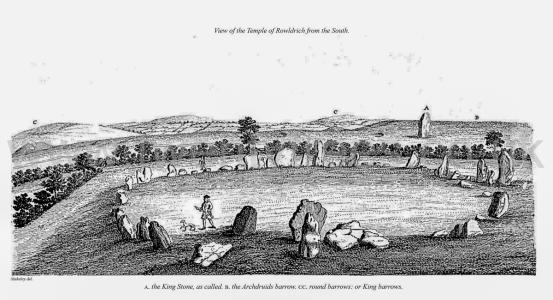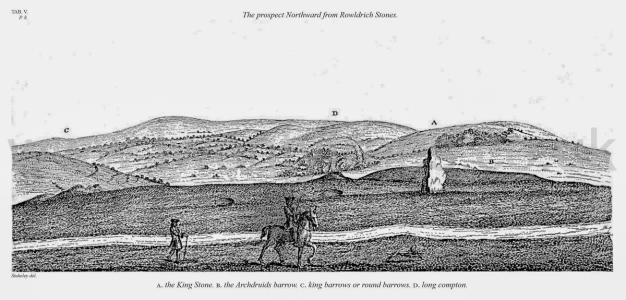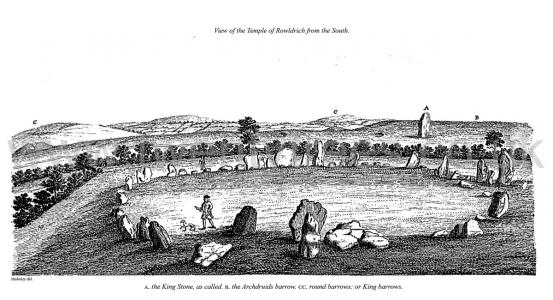Europe, British Isles, South-Central England, Oxfordshire, Little Rollright, King Stone [Map]
King Stone is in Little Rollright, Oxfordshire, Cotswolds Standing Stones.
Carbon Date. 1490BC. Late Bronze Age Carbon Dates
Report: Charcoal, id as Corylus sp (V Straker), from scattered deposit, assoc with burnt stones and burnt human tooth from possible cremation beside round cairn next to King Stone [Map], sealed by rubble spill from collapse of cairn at the Rollright Stones (King Stone), Oxfordshire, England. Comment (subm): May suggest Beaker or EBA date for cairn rather than earlier date. See also monograph.
ID: 1621, C14 ID: BM-2430 Date BP: 3490 +/- 70, Start Date BP: 3420, End BP: 3560
Abstract: Cairn, ploughed-out barrow and standing stone
Archaeologist Name: G Lambrick (Oxford Archaeol Unit)
Reference Name: Radiocarbon, 29, 1987, 185-6; Lambrick, G, 'The Rollright Stones' (= English Heritage Archaeol Rep, 6), 1988, 110
Council for British Archaeology (2012) Archaeological Site Index to Radiocarbon Dates from Great Britain and Ireland [data-set]. York: Archaeology Data Service [distributor] https://doi.org/10.5284/1017767
Carbon Date. 1480BC. Late Bronze Age Carbon Dates
Report: Charcoal, id as Corylus sp (M Robinson), from cremation deposit at base of posthole in round barrow ca 40m NW of King Stone [Map] at Rollright Stones (King Stone), Oxfordshire, England. Comment (subm): Of interest in view of possible function of King Stone as cemetery marker. See also monograph.
ID: 1619, C14 ID: BM-2428 Date BP: 3480 +/- 50, Start Date BP: 3430, End BP: 3530
Abstract: Cairn, ploughed-out barrow and standing stone
Archaeologist Name: G Lambrick (Oxford Archaeol Unit)
Reference Name: Radiocarbon, 29, 1987, 185-6; Lambrick, G, 'The Rollright Stones' (= English Heritage Archaeol Rep, 6), 1988, 110
Council for British Archaeology (2012) Archaeological Site Index to Radiocarbon Dates from Great Britain and Ireland [data-set]. York: Archaeology Data Service [distributor] https://doi.org/10.5284/1017767
Carbon Date. 1370BC. Late Bronze Age Carbon Dates
Report: Charcoal, id as mixed Quercus and Corylus spp (V Straker), from cremation secondary to construction of round cairn next to King Stone [Map], overlying first trace of collapsed cairn material and sealed by further collapse and rubble at Rollright Stones (King Stone), Oxfordshire, England. Comment (subm): May suggest Beaker or EBA date for cairn, rather than later. See also monograph.
ID: 1618, C14 ID: BM-2427 Date BP: 3370 +/- 40, Start Date BP: 3330, End BP: 3410
Abstract: Cairn, ploughed-out barrow and standing stone
Archaeologist Name: G Lambrick (Oxford Archaeol Unit)
Reference Name: Radiocarbon, 29, 1987, 185-6; Lambrick, G, 'The Rollright Stones' (= English Heritage Archaeol Rep, 6), 1988, 110
Council for British Archaeology (2012) Archaeological Site Index to Radiocarbon Dates from Great Britain and Ireland [data-set]. York: Archaeology Data Service [distributor] https://doi.org/10.5284/1017767
Carbon Date. 1320BC. Late Bronze Age Carbon Dates
Report: Charcoal, id as Corylus sp (M Robinson), from cremation deposit in pit in round barrow assoc with Collared Urn at the Rollright Stones (King Stone [Map]), Oxfordshire, England. Comment (subm): Deposit was adjacent to that dated by BM-2428. Result is within later end of range expected for Collared Urns. See also monograph.
ID: 1620, C14 ID: BM-2429 Date BP: 3320 +/- 90, Start Date BP: 3230, End BP: 3410
Abstract: Cairn, ploughed-out barrow and standing stone
Archaeologist Name: G Lambrick (Oxford Archaeol Unit)
Reference Name: Radiocarbon, 29, 1987, 185-6' Lambrick, G, 'The Rollright Stones' (= English Heritage Archaeol Rep, 6), 1988, 110
Council for British Archaeology (2012) Archaeological Site Index to Radiocarbon Dates from Great Britain and Ireland [data-set]. York: Archaeology Data Service [distributor] https://doi.org/10.5284/1017767
Avebury by William Stukeley. Roger Gale, "for Dr. Stukeley, to be left at the Grecian Coffee House in Devereux Court, near Temple Barr, London."— H. C. [This MS. Letter is in the possession of the Rev. H. F. St John].
Worcester, Augt 19, 1719.
Sir,
Last Saturday morning I had the satisfaction to see the stones called Rollrick [Map], which are but a molehill to a mountain in comparison of those we saw at Stonehenge and at Abury, and seem to have been intirely of another nature and design, as I doubt not but you will agree, upon my giving you the best description that I can of them. They are pitcht upon the top of a hill about half a mile south west of a village called Long Oompton, just within a hedge that now parts n ploughed field from a heath, and no doubt when these stones were placed there it was all heath. They compose a ring, not exactly circular8, the diameter of it from north to south being 35 yards9, and that from east to west but 33. The stones are of unequall dimensions both as to highth, breadth, and thicknesse, few of them exceeding 4 foot in altitude, and some of them reaching scarce two;10 and the breadth so various that I must have measured every stone to have given it you ; neither can I tell you the number, some being thrown down and broken, and others carryed away, but there are yet 22 standing11, and some of them pitcht so close together, edge by edge, that it is evident they were intended to form a close wall.12 The thicknesse of them is not above 14 or 16 inches. Where the entrance of it was is hard to say positively since there are many smooth gaps now in the ring, but as there is one directly north-east13 [King Stone [Map]] in a line to the King, as they call it, I am persuaded it was there. This King is a great stone which the countrey fancys represents a man on horseback, standing 84 yards14 N.E. of the circle, 8 foot high, 7 broad in the broadest part, and about 12 inches thick, and has, as appears by the gritt of the stone, been taken out of a quarry (as well as those atten- dants he has in the circle) within a hundred yards of his majesty, which observation of mine much displeased my landlord that came from Chipping Norton with me to show me this petrifyed court, which is the creed of the countrey , and he that contradicts it is lookt upon as most audacious free thinker.
I had like to have forgott observing that just in the north point of the circle is allso standing one stone much larger than the rest, being 7 foot high and 5i broad. I could observe no trench running round it, which, if there ever had been one, must still have shown itself upon the heath; nor any marks of an avenue leading to it, nor any barrows or tumuli within view of it, only a bank about 10 yards north of the King, in length about 20 yards, breadth 7, flatt and uneven on the top, as if made out of the rubbish of the neighbouring quarry.
The losse of your company in this journey I am every day more sensible of than the last, having many a heavy hour hang- ing upon my hands which your conversation would have made not onely to passe much easyer but profitably ; 6 long days more have I to lugg through in tiiis city, where the highest antiquity I can meet with rises no higher than the dusty traditionall tombs of a Saxon bishop or two. Which way I shall steer next I can- not determine yet, but if you will favour me with a line how matters go in both Societys, or with anything else you may think worth writing, by Satturday's post, it will be here on Monday morning ; if I cannot be so happy as to hear from you till after that time, be pleased to send your letter to my bouse, and it
will be forwarded thence to me. My service to all friends, and believe me, dear Sir,
Your most faithfull Friend, and humble Servant,
R. Gale.
P.S. In all probability it [the bank] is as ancient as the King himself, I mean cast up at the same time he was sett there, the countrey tradition joyning them together in a rhyme they all have.
If Long Compton thou canst see,
Then King of England thou shalt be.
You cannot see Long Compton where this King stands, but if you step a yard to the north of him it discovers itself over the top of this bank which intercepts it from his view.15
Note 8. Not far from being a true circle.
Note 9. The diameter from north to south is 101 feet, and not 105.
Note 10. The tallest stone is on the north boundary of the circle, and is 7 feet 4 inches high, and 8 feet wide at the gronnd IcTel ; scTen of the standing stones exceed 4 feet, aad one only ia less than 2 feet
Note 11. In 1S40, Sir Henry Dryden and the editor of these Diaries and Letters, made a careful ground plan of the circle, with elevations of the standing stones. At that date 22 stones were standing, the same number as stated by Roger Oale. About 80 were prostrate, and several must have been removed since 1719.
Note 12. Most probably this was the intention, for where two or more stones are still erect and near each other, they are as close as their irregular outlines will allow.
Note 13. There is no trace whatever of an avenue, or of any distinctly marked entrance.
Note 14. The distance from the drde to the king stone is 76 yards. The 9 feet 2 inches high, 6 feet wide at the ground level, and IS inches thick.
Note 15. This letter is referred to in Stukeley's Hist. of Abury, p. 11.
Avebury by William Stukeley. Near the arch-druid's barrow, by that called the Kingstone [Map], is a square plat, oblong, formed on the turf. Hither, on a certain day of the year, the young men and maidens customarily meet, and make merry with cakes and ale. And this seems to be the remain of the very ancient festival here celebrated in memory of the interred, for whom the long barrow and temple were made. This was the sepulture of the arch-druid founder. At Enston, a little way off, between Neat Enston and Fulwell, by the side of a bank or tumulus, stands a great stone, with other smaller. 'Tis half a mile south-west of Enston church. A famous barrow at Lineham, by the banks of the Evenlode.
Avebury by William Stukeley. 7. Mr. Camden writes further concerning our antiquity, that "the country people have a fond tradition, that they were once men, turned into stones. The highest of all, which lies out of the ring, they call the king [Map]. Five larger stones [Map], which are at some distance from the circle, set close together, they pretend were knights, the ring were common soldiers." This story the country people, for some miles round, are very fond of, and take it very ill if any one doubts of it; nay, they are in danger of being stoned for their unbelief. They have likewise rhymes and sayings relating thereto. Suchlike reports are to be met with in other like works, our Druid temples. They savour of the most ancient and heroic times. Like Perseus, turning men into stones; like Cadmus, producing men from serpents' teeth; like Deucalion, by throwing stones over his head, and such like, which we shall have occasion to mention again, chap. XIV.
Avebury by William Stukeley. 6. Another argument of its being a Druid temple, is taken from the barrows all around it, according to the constant practice in these places. To the north-east is a great tumulus or barrow of a long form, which I suppose to have been of an arch-druid. Between it and our temple is a huge stone standing upright, called the kingstone [Map]; the stone is 8 foot high, 7 broad, which, together with the barrow, may be seen in Tables III, V. but the barrow has had much dug away from it. 'Tis now above 60 foot in length, 20 in breadth, flattish at top.
I know not whether there were more stones standing originally about this barrow, or that this belonged to some part of the administration of religious offices in the temple, as a single stone.
In the same plate may be seen another barrow, but circular, below the road to the left hand, on the side of the hill. Under it is a spring-head running eastward to Long Compton. This barrow has had stone-work at the east end of it. Upon this same heath eastward, in the way to Banbury, are many barrows of different shapes, within sight of Rowldrich; particularly, near a place called Chapel on the heath, is a large, flat, and circular tumulus, ditched about, with a small tump in the center: this is what I call a Druid's barrow; many such near Stonehenge, some whereof I opened; a small circular barrow a little way off it. There are on this heath too, many circular dish-like cavities, as near Stonehenge, we may call them barrows inverted.

 Tables III and V.
Tables III and V.
Avebury by William Stukeley. 1724. Table V. The prospect Northward from Rowldrich Stones [Map]. A. the King Stone [Map]. B. the Archdruids barrow. C. king barrows or round barrows. D. long compton.

Avebury by William Stukeley. 1724. View of the Temple of Rowldrich [Map] from the South. A. the King Stone [Map] as called. B. the Archdruids barrow, CC rounds barrows or King barrows.

Long Barrows of the Cotswolds. King Stone [Map]